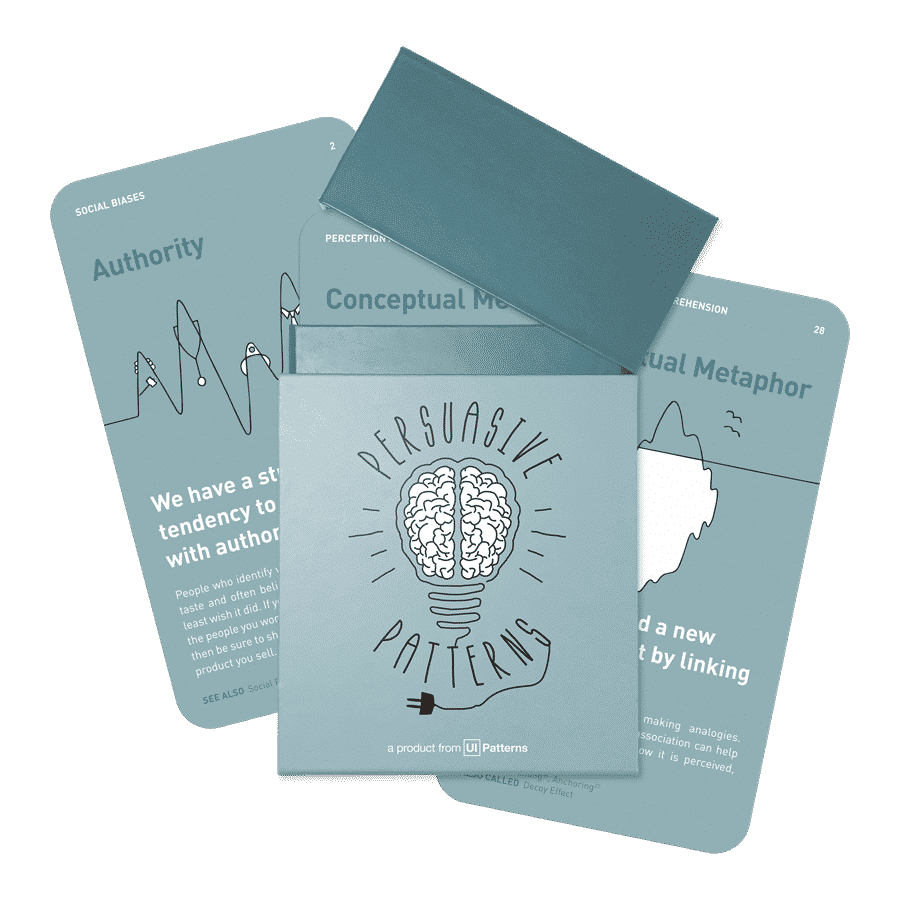Persuasive Technique
This persuasive pattern is part of the Persuasive Patterns printed card deck.
The Persuasive Patterns Card Deck is a collection of 60 design patterns driven by psychology, presented in a manner easily referenced and used as a brainstorming tool.
Get your deck!The status pattern taps into social dynamics, where individuals are motivated by how their actions affect their position and how they are perceived by others. It motivates behavior by associating actions with social rewards or recognition. This can be effectively utilized in various applications to drive engagement, enhance loyalty, and influence decision-making by making status outcomes visible and desirable.
On community-driven platforms like online forums or gaming environments, the Status pattern is distinctly visible. Users often engage more deeply when their contributions lead to elevated status within the community. For example, a gaming platform may allow players to unlock exclusive badges or avatars as they achieve higher scores or complete significant milestones. These digital rewards publicly signal their expertise and commitment, enhancing their reputation among peers.
This concept is supported by psychological research which indicates that individuals are motivated by social standing and recognition, often adjusting their behaviors to align with perceived pathways to status improvement. In digital settings, such as social media and gaming, where user interaction and competition are prevalent, these dynamics are particularly influential. The pattern leverages fundamental aspects of social psychology, like the desire for recognition and esteem, to foster engagement and loyalty.
The study
Imagine a scenario: you’re walking down the street and witness a stranger trip and fall. Would your decision to help be influenced by the presence of others? Surprisingly, research suggests our desire to maintain a positive public image can be a powerful motivator. In a now-classic study conducted by Harvard Business School professor Michael Norton and his colleagues, researchers explored this concept through an experiment involving lipstick. Participants, all female college students, were presented with two different lipsticks: a high-end brand priced at $50 and a drugstore brand priced at $2. Both lipsticks were identical in color and quality, with the only difference being the brand and price.
Here’s where the social influence aspect comes in: The researchers manipulated the perception of public scrutiny. Half of the participants were told they would be applying the lipstick in front of a video camera, under the belief the footage would be shown to others. The remaining participants were simply asked to evaluate the lipsticks without any mention of being filmed.
The results were intriguing. When participants believed they would be observed applying the lipstick, their preferences shifted dramatically. In this scenario, a significantly higher percentage (73%) opted for the more expensive brand, compared to only 31% who chose the cheaper option. This suggests that the potential for public observation influenced their decision-making, prioritizing the status associated with a higher-priced product over the actual quality. This seemingly trivial choice highlights the significant role social perception plays in shaping our behavior.
Norton, M. I., & Fryer, R. J. (2003). Identity economics and the investment game. American Economic Review, 93(3), 1072-1095.
The influence of social perception on behavior has been recognized for centuries. Early philosophers like Aristotle acknowledged the importance of reputation and social standing in human motivation. However, the scientific exploration of this concept gained momentum in the 20th century. Pioneering work by scholars like Festinger (1954) laid the groundwork for understanding social comparison processes. Additionally, Cialdini (1984) identified social proof, a related concept where we conform to behaviors endorsed by the majority, as a powerful persuasive principle. These studies, along with advancements in Behavioral Economics, solidified the Status pattern as a cornerstone of persuasion.
The Status pattern leverages the fundamental human desire for social approval and a positive public image. It hinges on the psychological principle of social comparison, where individuals evaluate themselves relative to others. This theory, rooted in Social Psychology, posits that our sense of self-worth is shaped by how we compare ourselves to a social reference group. The Status pattern exploits this tendency by suggesting that certain actions or choices can enhance or diminish our social standing in the eyes of others.
Designing products with Status
Begin by clearly defining which behaviors will trigger status upgrades. This might include reaching certain milestones or exhibiting desired behaviors. For example, in a fitness app, unlocking a badge after completing 30 workouts directly ties effort to reward, enhancing motivation.
Ensure the features or statuses unlocked resonate with users’ goals. In an educational platform, progressively unlocking advanced modules keeps learners engaged and provides them with a sense of progression tailored to their learning journey.
To keep users from feeling overwhelmed, introduce new features and statuses gradually. This method helps maintain a manageable learning curve and supports users’ sense of competence as they master new challenges.
Similarly, it is crucial to balance the difficulty of tasks with user ability levels to prevent frustration or disengagement. Adequately challenging tasks that are attainable can keep users in a state of flow, enhancing their overall experience.
The user journey
Each level up is tied directly to their accomplishments, such as completing set numbers of lessons or mastering complex grammatical structures.
As users progress, they encounter challenges calibrated just above their current level of competence, encouraging them to stretch their skills without becoming overwhelmed. This gradual increase in difficulty is visually represented in the app through a dynamic progress bar, which fills up as they near the next status upgrade. It’s a clear and constant reminder of how close they are to their next goal, maintaining engagement and motivation.
The pivotal moment arrives when a user achieves a significant milestone—unlocking a coveted feature. This could be access to exclusive advanced courses or entry into a private community of high-level learners. The achievement is immediately recognized within the platform through celebratory notifications and is made visible to others in the community through badges displayed prominently on their profile.
With new features unlocked, the user now enjoys enhanced capabilities that not only reflect their higher status but also offer new ways to interact with the platform. This phase involves personalizing the user experience based on the unlocked features, ensuring that they align with the user’s ongoing goals and interests.
To maintain the user’s engagement now that they have reached a high status, you could introduce periodic challenges and community-driven events that encourage ongoing participation. Users can showcase their expertise by contributing to the community, further enhancing their status and encouraging others to follow in their footsteps.
Provide helpful feedback
Utilize visual tools like progress bars or achievement trees that clearly show how close users are to unlocking a new status. This not only makes the progression tangible but also keeps users informed about what is required to advance.
When a new status is unlocked, provide immediate, positive feedback to reinforce the behavior that led there. For example, a congratulatory notification or an introduction to new features can boost user engagement and satisfaction.
Entice to strive for a higher status
Showcasing user achievements and status levels publicly can motivate others within the community by establishing benchmarks and fostering a competitive yet collaborative environment.
Offering features or content that are accessible only to users who reach certain status levels can create a sense of exclusivity and drive engagement.
Tailor how status levels are communicated to match individual preferences. Some users might appreciate public recognition, while others might prefer more subtle indications of their status.
Link status upgrades to meaningful contributions to ensure that these accolades have real value and relevance to the user’s activities on the platform.
Common mistakes
Although powerful, there are a number of common design pitfalls designers should be aware of:
- Overly focusing on gamification
Solely relying on points, badges, and leaderboards can feel gimmicky and detract from the core user experience. Focus on meaningful achievements and value associated with status indicators. - Overemphasis on competitive status
Focusing too much on competition can create a toxic environment, deterring new or less competitive users. - Inauthentic exclusivity
Creating exclusive features solely to drive engagement without genuine value can backfire. Ensure exclusive offerings provide a clear benefit that justifies their limited access. - Ignoring user preferences
Not tailoring status cues to individual preferences can alienate users. Offer options for public or private recognition to cater to diverse needs. - Lack of transparency in status achievement
If the criteria for achieving status are not clear, users may feel frustrated and less motivated. - Ignoring user diversity
Not every user is motivated by the same rewards. A system that does not account for diverse motivations can fail to engage all user segments.
Ethical recommendations
The Status pattern, while effective in motivating behavior and fostering engagement, can be susceptible to misuse, potentially leading to negative consequences for users. One major concern is the creation of overly competitive or exclusionary environments. In settings where status becomes a predominant focus, there’s a risk that it can foster toxic competitiveness, where users may go to extreme lengths to outdo others, leading to stress, anxiety, or unethical behaviors such as gaming the system or harassing other users to maintain or elevate their status.
Another ethical concern arises when the desire for status leads to a divide between new and long-standing users. High-status users might dominate conversations and decision-making processes, marginalizing newer or less active members who may feel undervalued or powerless, thus potentially stunting community growth and diversity.
Other potential pitfalls that can be misused to manipulate user behavior in ways that prioritize business goals over user well-being are:
- Superficial statuses
Overemphasizing metrics like points or badges can create a shallow sense of status disconnected from genuine accomplishments. This can lead to gamified experiences that feel inauthentic and ultimately demotivate users. - Pressure and anxiety
Focusing solely on competition and maintaining high status can create a stressful and anxiety-inducing user experience. Users might feel pressured to constantly engage and compete, neglecting the core value proposition of the product.
To mitigate these potential pitfalls, consider:
- A focus on meaningful recognition
Highlight achievements that demonstrate genuine user contributions or mastery of a skill. This fosters a sense of accomplishment and intrinsic motivation, as opposed to extrinsic rewards solely focused on status. - Transparency and control
Be transparent about how status is achieved and maintained. Offer users control over how their status is displayed publicly. This empowers users and avoids manipulative tactics that exploit the desire for social approval. - Prioritize user value
Always prioritize user experience and value over achieving high engagement metrics through manipulation. The “Status” pattern should enhance the user journey, not create an environment of pressure and anxiety.
Examples
Airbnb
Airbnb rewards hosts who provide exceptional experiences with a “Superhost” status. This status is visible on their listings and comes with benefits like more visibility and potential for increased bookings, motivating hosts to maintain high standards.
Amazon
Amazon awards status based on the helpfulness of user reviews. Top reviewers gain visibility and often receive perks from manufacturers, incentivizing detailed and helpful review submissions.
LinkedIn utilizes the status pattern by allowing users to endorse each other’s skills and write recommendations. This feature boosts the perceived professional status of users, encouraging more engagement and networking within the platform.
Trigger Questions
- What user achievements or contributions can we celebrate?
- Can we offer exclusive experiences that provide real value?
- How can we personalize status indicators for individual users?
- Do our status cues reflect meaningful accomplishments or superficial metrics?
- How can we ensure our design motivates and rewards users genuinely?
- How do we ensure that the status rewards align with our users' values and goals?
- What mechanisms are in place to prevent the system from being gamed?
- Are the status levels attainable and motivating for new users as well as veterans?
- How do we balance the needs of competitive versus cooperative participants in our platform?
- In what ways can we personalize the achievement experience to cater to diverse user groups?
- What fallback mechanisms do we have if users start to lose interest after achieving high status?
Pairings
Status + Social Proof
This pairing is a potent combination. Social proof leverages the influence of the majority, while the Status pattern emphasizes the value of being associated with that majority. For instance, Airbnb showcases listings with Superhost badges, indicating high user ratings. This social proof, combined with the elevated status associated with Superhost designation, incentivizes hosts to provide exceptional service and users to book with confidence.

We constantly look to how our actions improve or impair how others see us

We assume the actions of others in new or unfamiliar situations
Status + Authority Bias
People are naturally inclined to trust and follow figures perceived as experts. Combining this with the Status pattern strengthens the persuasive effect. For example, Masterclass features online courses taught by renowned instructors. The instructor’s authority, coupled with the status associated with learning from such an expert, motivates users to enroll in the courses.

We constantly look to how our actions improve or impair how others see us

We have a strong tendency to comply with authority figures
Status + Reciprocity
The principle of reciprocity suggests that people feel obligated to return favors. Combining this with Status can create a powerful loop. For example, Stack Overflow awards points and badges for user contributions. These status indicators incentivize users to answer questions and contribute to the platform, fostering a sense of community and reciprocity.

We constantly look to how our actions improve or impair how others see us

We feel obliged to give when we receive
Status + Loss Aversion
People are more sensitive to potential losses than gains. The Status pattern can be used to frame potential losses in a way that motivates action. For instance, Loyalty programs might notify users nearing expiration of their high-tier status, prompting them to engage more to retain those benefits. This leverages loss aversion, coupled with the desire to maintain elevated status, to encourage continued participation.

We constantly look to how our actions improve or impair how others see us

Our fear of losing motivates us more than the prospect of gaining
Status + Scarcity Bias
Limited availability can make something seem more desirable. The Status pattern can amplify this effect. For example, Limited-edition product releases create a sense of exclusivity and status for those who acquire them. The combination of scarcity and the elevated status associated with owning a limited-edition item drives demand and motivates users to act quickly.

We constantly look to how our actions improve or impair how others see us

We value something more when it is in short supply
Status + Rewards
Intertwining rewards with status enhancements can be highly effective. For example, frequent flyer programs offer tiered statuses, each with its own set of rewards, incentivizing customers to increase their engagement to reach higher status levels.

We constantly look to how our actions improve or impair how others see us

Use rewards to encourage continuation of wanted behavior
This persuasive pattern is part of the Persuasive Patterns printed card deck.
The Persuasive Patterns Card Deck is a collection of 60 design patterns driven by psychology, presented in a manner easily referenced and used as a brainstorming tool.
Get your deck!- The Social Power of a Uniform by Bickman
- Social Psychology by Baron & Branscombe
- Fiske, S. T. (2010). Social Beings: Core Motives in Social Psychology (3rd ed.). Wiley.
- Leary, M. R., & Kowalski, R. M. (1990). Impression management: A literature review and two-component model. Psychological Bulletin, 107(1), 34-47.
- Baumeister, R. F., & Leary, M. R. (1995). The need to belong: Desire for interpersonal attachments as a fundamental human motivation. Psychological Bulletin, 117(3), 497-529.
- Willer, R. (2009). Groups reward individual sacrifice: The status solution to the collective action problem. American Sociological Review, 74(1), 23-43.
- Cialdini, R. B. (1984). Influence: The psychology of persuasion. HarperCollins Publishers.
- Festinger, L. A. (1954). A theory of social comparison processes. Human Relations, 7(2), 117-140.
- Asch, S. E. (1951). Effects of group pressure upon the modification and distortion of judgments. In H. Guetzkow (Ed.), Groups, leadership and men (pp. 177-190). Carnegie Press.
- Belk, R. W. (1988). Possessions and the extended self. Journal of Consumer Research, 15(1), 139-164.
- Bickman, Leonard (1974). The Social Power of a Uniform. Journal of Applied Social Psychology. 4 (1): 47–61
- Baron & Branscombe (2012). Social Psychology. United States of America: Pearson Education, Inc. pp. 127–28
